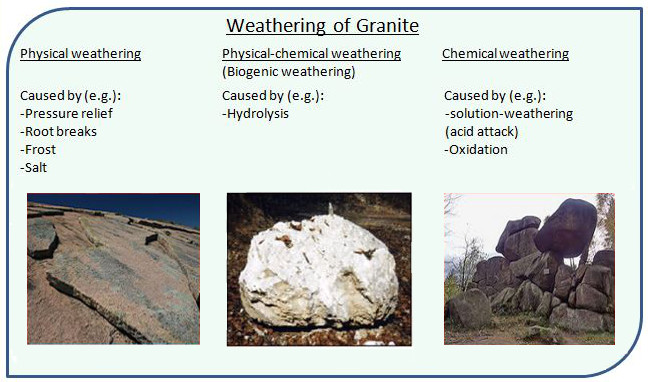Link zur deutschen Übersetzung unten/Link to a german translation below.


青藏高原被认为是地球上最高的地区。 它平均海拔高度约4500米,但也包括喜马拉雅山脉的大部分山峰超过8000米。 它们是在大约5000万年前形成的,印度板块钻入亚洲大陆,喜马拉雅山脉展开,因此西藏的高地也起源于此.
除了该地区的许多其他地质特征外,您访问过的Earthcache也是观察风化过程如何发生的好方法,以及现有山体结构如何赋予其独特的外观。
有几种类型的岩石风化:化学,生物和风化。这些过程通常同时并行运行。但是,根据其影响力和其他环境影响,它们会导致截然不同的结果
例如,对于物理风化,包括形成裂缝和裂缝的压力释放。 此外,它可以导致整个壳体的消除或剥落和破碎的小碎片. 在这里,人们谈到所谓的洋葱壳风化。这可以通过尖锐边缘和分层风化图案的存在容易地识别。
如果化学风化侵蚀花岗岩,例如在水解过程中,晶格的矿物质被H +离子取代。风化强度随着温度和水的酸度而增加。 由于这种风化形式通常是天气模式. 这些让人想起堆叠的羊毛袋, 在垂直和水平延伸,强烈圆润的边缘上易于识别. 里面的花岗岩体仍然完好无损.
生物风化结合了物理和化学过程。 岩石首先受到植物根系和土壤生物呼吸的影响,CO2浓度大大增加,有利于水解。

你的任务:
转到修道院区域的列表坐标。你站在大会堂的前面有3个台阶,你可以在背景中看到北/东北的高岩层。 修道院的开放时间通常在9点到16点之间。 在这些时间之外,或者如果您不想支付55元的入场费(截至2018年10月),您也可以回答修道院外的WP2问题。
1. 用你自己的话描述这些岩石的外观。
2. 考虑到你已经在3650米左右,估计它们的海拔高度。
3. 这些洋葱皮 - 或羊毛袋是否风化?解释你为什么这么想。
4. 请自行研究:哪些国家和/或地区仍有特别好的风化形式?
5. 根据您的确切位置,您可以去修道院3或以上的大石头 发现更多的人造物. 问题:这些是什么,为什么会这样 在石头上使用你认识到的风化模式比在石头上更好 其他?
6. 可选:如果您在大会堂前面或美丽的修道院内的其他地方拍摄好照片并将其上传到日志中,我们将非常高兴。 请不要看到岩石或其上的东西的扰流照片。
警告:
根据指南,您不必等待日志发布。但是在日志之前或最晚将答案发送给我们。 没有日志像:“我发送 以后回答......“”如果我有更好的互联网......“”当我回家......“等. 我们将删除此类日志而无需进一步查询。 如果您撰写通用答案,请包括他们应该申请的团队。
The Tibetan Plateau is considered the highest region on earth. It is on average at a height of about 4500m above sea level, but also covers a large part of the Himalayan Mountains with mountain peaks of over 8000m. They were formed about 50 million years ago. As the Indian plate drilled into the Asian continent, the Himalaya folded up and thereby also the highlands of Tibet originated.
In addition to many other geological features of the region visiting this Earthcache is a great way to observe how weathering processes occurs and how the existing mountain structures got their own characteristic appearance.
The weathering of granite results in several distinguishable types: Chemical, biogenic and physical. Often these results can be seen side by side at the same time. However, depending on their intensity and other environmental influences, they lead to very different results.
Physical weathering for example also includes pressure relief that forms cracks and crevices. In addition it can lead to separation of entire shells or to peeling and chipping of small fragments (desquamation). It is called onion-shell weathering. This can be seen on existing sharp edges in a layered weathering pattern, the so-called onion-shell weathering.
If the chemical weathering attacks the granite, for instance the minerals of the crystal lattice are replaced by H + ions during hydrolysis (acid attack). The intensity of the weathering increases with the temperature and the acid content of the water. As a result of this type of weathering are typically weathering images created, which remind of stacked woolen sacks and can easily be seen on vertically and horizontally running, strongly rounded edges while the granite body is still unscathed in the interior.
Biogenic weathering combines both physical and chemical processes. The rock is first blown up by plant roots, and the CO2 concentration is greatly increased by the respiration of soil organisms, which aids hydrolysis.

Your tasks:
Go to the given coordinates inside the monastery. You’ll stand on 3 steps in front of the Assembly Hall and looking north/northeast you can see high rock formations in the background. The opening hours of the monastery are usually between 9am to 4pm. Out of the opening times or if you don`t want to pay the small entry fee of 55 Yuan (Oct. 2018) you can also answer the questions by observing at the coordinates around waypoint 2.
1. Please describe in your own words the appearance of those rocks.
2. Estimate their height above sea level (considering that you are already at about 3650 m).
3. Does it appear onion-shell or woolen sacks weathering? Explain, why you think that!
4. Please research independently: In which other countries and/or regions are there especially good examples of the weathering you see here?
5. Depending on your exactly position, you may discover 3 or more man-made things on large stones above the monastery. Question: What are these things and why are they better to create on stones with the weathering form you’ve recognized than on the other?
6. Optional: If you would take a nice photo of you in front of the Assembly Hall or somewhere else inside the beauteous monastery and upload it to the log we would be very happy. Please no spoiler photos of the rocks or the things on them.
Please note:
According to the guidelines you have not to wait for our permission, but send the answer e-mail immediately together with the log! No logs like: "Will send the answers later, when back home, when having better internet", etc. Such logs will deleted by us without prior notification. If your answers should be valid for another teams too, please provide their names.
Für die deutsche Übersetzung klicke/for the german translation click hier/here.